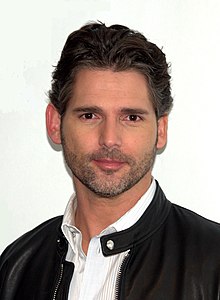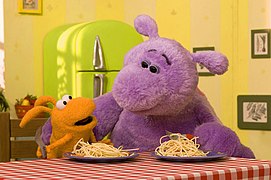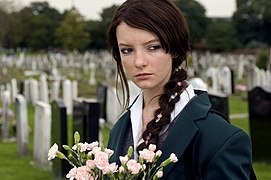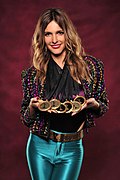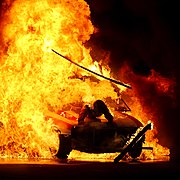The Television Portal

Television (TV) is a telecommunication medium for transmitting moving images and sound. Additionally, the term can refer to a physical television set rather than the medium of transmission. Television is a mass medium for advertising, entertainment, news, and sports. The medium is capable of more than "radio broadcasting," which refers to an audio signal sent to radio receivers.
Television became available in crude experimental forms in the 1920s, but only after several years of further development was the new technology marketed to consumers. After World War II, an improved form of black-and-white television broadcasting became popular in the United Kingdom and the United States, and television sets became commonplace in homes, businesses, and institutions. During the 1950s, television was the primary medium for influencing public opinion. In the mid-1960s, color broadcasting was introduced in the U.S. and most other developed countries.
In 2013, 79% of the world's households owned a television set. The replacement of earlier cathode-ray tube (CRT) screen displays with compact, energy-efficient, flat-panel alternative technologies such as LCDs (both fluorescent-backlit and LED), OLED displays, and plasma displays was a hardware revolution that began with computer monitors in the late 1990s. Most television sets sold in the 2000s were flat-panel, mainly LEDs. Major manufacturers announced the discontinuation of CRT, Digital Light Processing (DLP), plasma, and even fluorescent-backlit LCDs by the mid-2010s. LEDs are being gradually replaced by OLEDs. Also, major manufacturers have started increasingly producing smart TVs in the mid-2010s. Smart TVs with integrated Internet and Web 2.0 functions became the dominant form of television by the late 2010s. (Full article...)
Selected article -
Selected image -

Closed captioning (CC) and subtitling are both processes of displaying text on a television, video screen, or other visual display to provide additional or interpretive information. Both are typically used as a transcription of the audio portion of a program as it occurs (either verbatim or in edited form), sometimes including descriptions of non-speech elements. Other uses have been to provide a textual alternative language translation of a presentation's primary audio language that is usually burned-in (or "open") to the video and not selectable (or "closed"). HTML5 defines subtitles as a "transcription or translation of the dialogue ... when sound is available but not understood" by the viewer (for example, dialogue in a foreign language) and captions as a "transcription or translation of the dialogue, sound effects, relevant musical cues, and other relevant audio information ... when sound is unavailable or not clearly audible" (for example, when audio is muted or the viewer is deaf or hard of hearing").
Did you know (auto-generated) -

- ... that to prepare for her role in the television film Search for Grace, actress Lisa Hartman Black underwent hypnosis?
- ... that after being wiped by the BBC, all four episodes of the Doctor Who serial The Time Meddler were discovered in Nigeria in 1984?
- ... that the television series The Owl's Legacy was modelled after the ancient Greek symposium?
- ... that the Fox television network successfully moved to strip an Iowa TV station of its affiliation?
- ... that Filipina actress Angel Aquino has been described as a "perennial villainess" for portraying several antagonistic roles on television?
- ... that North Carolina television station WNAO-TV operated from a converted supper club?
Selected quote -
More did you know
- ...that the title of Dan Castellaneta's album of comedy sketches I Am Not Homer is a parody of Leonard Nimoy's first autobiography I Am Not Spock?
- ...that the fight scene between Peter Griffin and a giant chicken on Family Guy episode Blind Ambition was originally created for the episode Cleveland Loretta Quagmire?
- ...that Dyesebel, a popular mermaid character in Filipino comic books, cinema and television, was based on Philippine folklore?
- ...that the final episode of the 1986 television series Outlaws recycled footage from The Oregon Trail, because actors Rod Taylor and Charles Napier appeared in both programs?
- ...that Great American Country television host Nan Kelley (then Nan Sumrall) became Miss Mississippi in 1985 after her fellow Mississippian Susan Akin was crowned Miss America?
Selected biography -
Eric Martin Andrew Banadinović AM (born 9 August 1968), known professionally as Eric Bana (/ˈbænə/), is an Australian actor, comedian, producer, and director. He began his career in the sketch comedy series Full Frontal before gaining notice in the comedy drama The Castle (1997). He achieved further critical recognition for starring in the biographical crime film Chopper (2000), and as the titular character in Hulk (2003).
After a decade of roles in Australian television shows and films, Bana gained Hollywood's attention for his performance in the war film Black Hawk Down (2001). He played Hector in the war epic Troy (2004), and took a leading role in Steven Spielberg's historical thriller Munich (2005). In 2009, he played the villain Nero in the science-fiction film Star Trek, which was a critical and commercial success. Bana continued to work steadily in the 2010s, portraying Lieutenant commander Erik S. Kristensen in Lone Survivor (2013), and playing police sergeant Ralph Sarchie in the horror film Deliver Us from Evil (2014). In 2018, Bana played the title role in a true crime miniseries, Dirty John. In 2020, he returned to Australia to star in outback thriller The Dry. (Full article...)
General images
News
- December 28: US professional wrestler Jon Huber dies aged 41
- September 2: Tributes paid to recently deceased US actor Chadwick Boseman
- May 24: Japanese professional wrestler and Netflix star Hana Kimura dies aged 22
- January 16: BBC newsreader Alagiah to undergo treatment for bowel cancer
- Upcoming events
Featured content
Main topics
History of television: Early television stations • Geographical usage of television • Golden Age of Television • List of experimental television stations • List of years in television • Mechanical television • Social aspects of television • Television systems before 1940 • Timeline of the introduction of television in countries • Timeline of the introduction of color television in countries
Inventors and pioneers: John Logie Baird • Alan Blumlein • Walter Bruch • Alan Archibald Campbell-Swinton • Allen B. DuMont • Philo Taylor Farnsworth • Charles Francis Jenkins • Boris Grabovsky • Paul Gottlieb Nipkow • Constantin Perskyi • Boris Rosing • David Sarnoff • Kálmán Tihanyi • Vladimir Zworykin
Technology: Comparison of display technology • Digital television • Liquid crystal display television • Large-screen television technology • Technology of television
Terms: Broadcast television systems • Composite monitor • HDTV • Liquid crystal display television • PAL • Picture-in-picture • Pay-per-view • Plasma display • NICAM • NTSC • SECAM
Categories
WikiProjects

|
You are invited to participate in WikiProject Television, a WikiProject dedicated to developing and improving articles about Television. |
- Main projects
- Sub-projects
Television Stations • American animation • American television • Australian television • British TV • BBC • Canadian TV shows • Television Game Shows • ITC Entertainment Productions • Digimon • Buffyverse • Doctor Who • Degrassi • EastEnders • Episode coverage • Firefly • Futurama • Grey's Anatomy • Indian television • Lost • Nickelodeon • The O.C. • Professional Wrestling • Reality TV • The Simpsons • Seinfeld • South Park • Stargate • Star Trek • Star Wars • Soap operas • Avatar: The Last Airbender • House
- Related projects
Animation • Anime and manga • Comedy • Comics • Fictional characters • Film • Media franchises
What are WikiProjects?
Things you can do

- Place the {{WikiProject Television}} project banner on the talk pages of all articles within the scope of the project.
- Write: Possible Possum
- Cleanup: color television, Alien Nation: Body and Soul, The Sopranos, Alien Nation: Dark Horizon, Alien Nation: The Enemy Within, Alien Nation: Millennium, Aang
- Expand: Timeline of the introduction of color television in countries
- Stubs: Flow (television), Just for Kicks (TV series), Play of the Month, Nova (Dutch TV series), More stubs...
Subportals
Related portals
Associated Wikimedia
The following Wikimedia Foundation sister projects provide more on this subject:
-
Commons
Free media repository -
Wikibooks
Free textbooks and manuals -
Wikidata
Free knowledge base -
Wikinews
Free-content news -
Wikiquote
Collection of quotations -
Wikisource
Free-content library -
Wikiversity
Free learning tools -
Wiktionary
Dictionary and thesaurus


